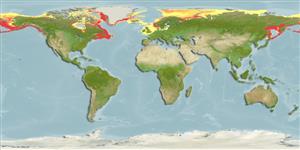>
Perciformes/Zoarcoidei (Eelpouts and pricklebacks) >
Lumpenidae (Eel pricklebacks)
Etymology: Leptoclinus: Greek, leptos = thin + Greek, klinein, kline = sloping and bed, due to the four apophyses of sphenoid bone (Ref. 45335).
Environment: milieu / climate zone / depth range / distribution range
البيئة
بحري القاع; نطاق العمق 2 - 607 m (Ref. 58426). Polar; -2°C - 2°C (Ref. 120227); 79°N - 43°N, 180°W - 180°E (Ref. 86838)
Circumpolar: Arctic to temperate waters; northern hemisphere. Arctic Alaska to Sea of Okhotsk, northern Sea of Japan, Unalaska Island in the Aleutian chain and Puget Sound, Washington, USA. North Atlantic: Arctic to Labrador in Canada; along Scandinavia from Skagerrak to Finnmarken, common at Murmansk, White Sea, Iceland and Greenland (Ref. 10006). The Pacific form is sometimes treated as a subspecies Leptoclinus maculatus diaphanocarus (Ref. 51666).
Length at first maturity / الحجم / وزن / العمر
Maturity: Lm 12.5, range 13 - 13 cm
Max length : 20.0 cm TL ذكر/ مختلط الجنس; (Ref. 35388)
الأشواك الظهرية (المجموع) : 57 - 60; الأشعة الظهرية الناعمة (المجموع) : 0; شوكة شرجية: 1 - 2; أشعه شرجية لينه: 34 - 36. Caudal rounded; lower 5 rays of pectorals greatly lengthened and exserted (Ref. 6885). Color greyish - yellow with dark irregular spots (Ref. 35388).
Adults, juveniles, and late postlarvae are found on sandy and mud to pebble bottoms, usually in less than 170 meters (Ref. 2850, 51666, 120227), while early postlarvae are pelagic (Ref. 120227). Food consists of polychaetes and crustaceans (Ref. 10571). They are an important prey for pelagic (as larvae) and benthic (as adults) predators (Ref. 120226). Sexual dimorphism is more pronounced after maturation with males displaying faster somatic growth (Ref. 120226). This marked dimorphism may well be linked with behavioral dissimilarities between males and
females, and is most likely associated with different roles during the breeding season with only adult males have large canines at the tip of upper jaw. It is assumed that males are territorial and defend their spawning sites, whereasfemales guard eggs within her partner’s territory (Ref. 128434).
Males exhibit territorial defence (Ref. 120226).
Eschmeyer, W.N., E.S. Herald and H. Hammann, 1983. A field guide to Pacific coast fishes of North America. Boston (MA, USA): Houghton Mifflin Company. xii+336 p. (Ref. 2850)
IUCN Red List Status (Ref. 130435: Version 2024-2)
استخدامات بشرية
مصائد:
أدوات
تقارير خاصة
Download XML
مصادر علي الأنترنت
Estimates based on models
Preferred temperature (Ref.
123201): 0.2 - 7, mean 2.3 °C (based on 1058 cells).
Phylogenetic diversity index (Ref.
82804): PD
50 = 1.0000 [Uniqueness, from 0.5 = low to 2.0 = high].
Bayesian length-weight: a=0.00363 (0.00151 - 0.00871), b=2.95 (2.74 - 3.16), in cm total length, based on LWR estimates for this (Sub)family-body shape (Ref.
93245).
مستوى غذائي (Ref.
69278): 3.3 ±0.39 se; based on food items.
Generation time: 11.1 ( na - na) years. Estimated as median ln(3)/K based on 2
growth studies.
المرونه (Ref.
120179): منخفض, الحد الزمني الأدني لتضاعف عدد أفراد المجتمع 4.5-14 سنة (tm=7; tmax=12; K=0.099; Fec=931).
Fishing Vulnerability (Ref.
59153): High vulnerability (59 of 100).
Nutrients (Ref.
124155): Calcium = 22.3 [4.8, 93.2] mg/100g; Iron = 0.512 [0.172, 1.359] mg/100g; Protein = 16.8 [14.9, 18.9] %; Omega3 = 0.288 [0.112, 0.751] g/100g; Selenium = 9.62 [3.01, 35.80] μg/100g; VitaminA = 35.4 [6.5, 194.5] μg/100g; Zinc = 0.57 [0.29, 1.21] mg/100g (wet weight);
